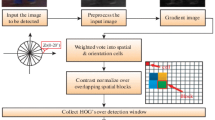Abstract
The need for greater interest in and the study of the pedestrian protection system is growing in the effort to minimize the human and material damages from traffic accidents and to improve traffic safety. Among the numerous methods for distinguishing key characteristics, particularly among those used for detecting pedestrians, the most frequently used method is the one that recognizes key characteristics using Histogram of Oriented Gradient (HOG). The method that relies on HOG for detecting pedestrians, however, requires a massive amount of calculations and is currently seeing a falling recognition rate owing to its unnecessary dimensions. As such, an algorithm with an improved pedestrian recognition rate was designed and realized in this study by reducing the number of dimensions for the characteristic vectors through the minimization of the unnecessary cell histogram calculations and the adoption of the UDP dimension reduction method. The developed algorithm was confirmed from such assessment that the algorithm demonstrated an about 11% processing speed improvement compared to HOG, the existing pedestrian recognition algorithm, and an about 3.98% recognition rate improvement and a 31% calculation speed improvement.







Similar content being viewed by others
References
Joo JW, Lee JK, Park JH (2015) Security considerations for a connected car. J Converg 6(2):1–9
Blanco-Gonzalo R, Poh N, Wong R, Sanchez-Reillo R (2015) Time evolution of face recognition in accessible scenarios. Hum Cent Comput Inf Sci 5(1):24
Park D-H (2015) A study on real-time Pedestrian recognition and tracking in car video. In: Proceedings of the Korean Society of Computer Information Conference, vol 23 no 2, pp 258–261
Kim P-K, Kim HH, Kim T-W (2017) An improved pedestrian detection system that utilizes the HOG-UDP algorithm. In: MUE 2017 FutureTech 2017: Advanced Multimedia and Ubiquitous Engineering, pp 218–225
Lee Y-S (2014) A study on risk factor in Pedestrian accidents. In: Proceedings of the Korean Society of Automotive Engineers Conference, p 796
Lee J-Y (2014) Implementation of Pedestrian recognition based on HOG using ROI for real time processing. J Instit Korean Electr Electron Eng 18(4):581–585
Wirz M (2013) Probing crowd density through smartphones in city-scale mass gatherings. EPJ Data Sci 2(1):1–24
Alsmirat MA, Jararweh Y, Al-Ayyoub M, Shehab MA, Gupta Brij B (2017) Accelerating compute intensive medical imaging segmentation algorithms using hybrid CPU-GPU implementations. Multimed Tools Appl 76(3):3537–3555
Wang Y-C (2014) Vehicle color classification using manifold learning methods from urban surveillance videos. EURASIP J Image Video Process 2014(1):1–20
Ammar C (2016) Evaluation of histograms local features and dimensionality reduction for 3D face verification. J Inf Process Syst 12(3):468–488
Al-Ayyoub M, Alzu’bi S, Jararweh Y, Shehab A (2016) Accelerating 3D medical volume segmentation using GPUs. In: Multimedia Tools and Applications, pp 1–20
Ababneh IM, Bani-Mohammad S, Al Smadi M (2015) Corner-boundary processor allocation for 3D mesh-connected multicomputers. Int J Cloud Appl Comput 5(1):1–13
Huang K, Wang F, Xu X, Cheng Y (2014) Pedestrian detection using HOG dimension reducing in video surveillance. Intell Data Anal Appl 2:221–229
Kobayashi T, Hidaka A, Kurita T (2008) Selection of histograms of oriented gradients features for Pedestrian detection. In: CONIP 2007: Neural Information Processing, pp 598–607
Kim C-M (2013) An efficient Pedestrian recognition method based on PCA reconstruction and HOG feature descriptor. J Instit Electron Eng Korea 50(10):162–170
Yang S-M (2013) HOG based Pedestrian detection and behavior pattern recognition for traffic signal control. J Instit Control 19(11):1017–1021
Yu J-H (2012) SPVD dimension reduction and SPVD query filter algorithms for target detection in hyperspectral image. J Korea Inf Sci Soc 39(6):406–415
Song M-K (2013) Music mood classification based on a new feature reduction method and modular neural network. J Korea Soc Ind Inf Syst 18(4):25–35
Kim W-D (2012) Design of optimized radial basis function neural networks classifier with the aid of principal component analysis and linear discriminant analysis. J Korean Instit Intell Syst 22(6):735–740
Author information
Authors and Affiliations
Corresponding author
Rights and permissions
About this article
Cite this article
Shim, JS., Ju, YW. & Park, SC. Design and implementation of a Pedestrian recognition algorithm using trilinear interpolation based on HOG-UDP. J Supercomput 74, 787–800 (2018). https://doi.org/10.1007/s11227-017-2160-1
Published:
Issue Date:
DOI: https://doi.org/10.1007/s11227-017-2160-1




